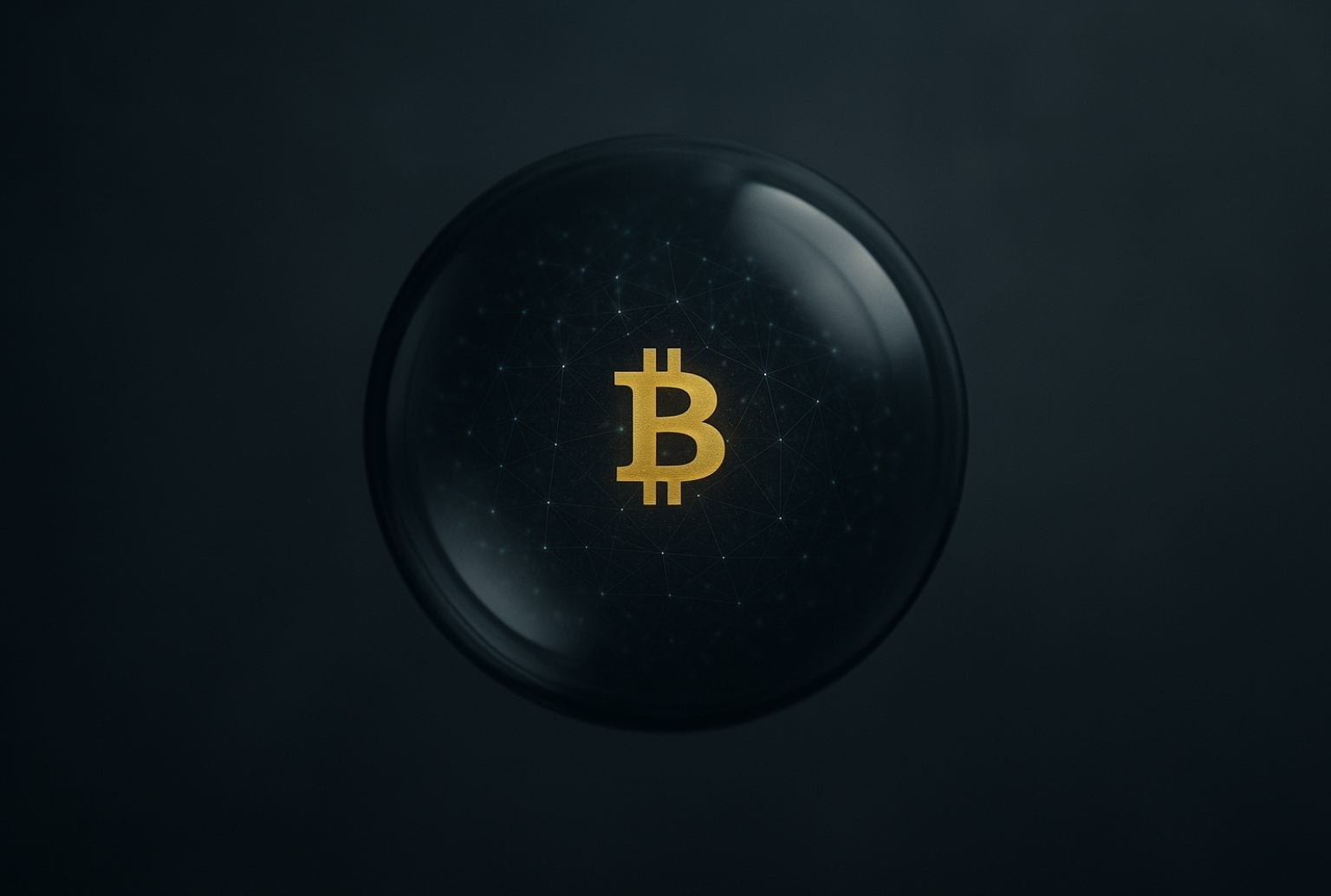Why DeFi is Inevitable

Decentralized Finance (DeFi) is transforming how financial systems operate by removing intermediaries like banks and enabling direct, peer-to-peer transactions. Accessible to anyone with internet access, DeFi offers transparency, lower costs, and user control over financial assets. The market's rapid growth is driven by blockchain innovation, smart contracts, and institutional interest. By 2033, DeFi's market size is projected to grow from $21.3 billion in 2023 to $616.1 billion, with a yearly growth rate of 40%.
Key Highlights:
- Accessibility: DeFi eliminates barriers like credit checks, allowing billions of unbanked individuals to access financial services.
- Transparency: Blockchain records every transaction publicly, ensuring accountability.
- User Control: DeFi users manage their own assets, bypassing traditional banking restrictions.
- Growth Stats: Total value locked (TVL) in DeFi protocols surged to $129 billion by January 2025, with Ethereum dominating 55% of the market.
- Innovation: Layer 2 solutions and cross-chain technology are reducing transaction costs and increasing efficiency.
DeFi is reshaping finance by offering an alternative system that's open, efficient, and rapidly advancing. Its growth signals a shift in how people interact with money, creating opportunities for both individuals and institutions.
DEFI - The Future Of Finance Explained
4 Key Factors Making DeFi Unstoppable
Four driving forces are pushing DeFi's momentum forward, breaking through traditional banking limitations and opening the door to more inclusive financial systems.
Open Access for Everyone
DeFi eliminates barriers that have kept billions of people away from financial services. Globally, more than two billion individuals remain unbanked, often due to economic instability or lack of access to traditional banking systems. Even in developed nations like the United States, many people cite insufficient funds as the primary reason for not having a bank account.
With DeFi, anyone with an internet connection can access financial tools without needing a bank. This permissionless structure ensures equal and secure access, offering diverse financial products and transparent transactions that can help reduce inequality. Real-world applications highlight this transformative potential. For instance, Kotani Pay, supported by the UNICEF Innovation Fund, allows Kenyans to convert cryptocurrency into local currency using basic mobile technology. Similarly, Leaf Wallet enables underserved communities and refugees to access digital financial services without the usual banking requirements. DeFi also makes microloans and micro-investments practical by spreading risk among multiple investors, creating opportunities for small-scale lending that’s both accessible and sustainable.
This open access naturally brings an unprecedented level of transparency to every financial transaction.
Complete Transparency Through Blockchain
Traditional banks operate behind closed doors, where customers must trust institutions to manage their money. DeFi, on the other hand, uses blockchain technology to ensure that every transaction is transparent. Smart contracts on platforms like Ethereum automatically log details such as timestamps and wallet addresses, creating a record that cannot be altered.
Joshua Odmark, CIO and Founder of Local Data Exchange, explains:
"I've been experimenting with smart contracts on Ethereum that automatically record every transaction detail, including timestamps and wallet addresses, making it impossible to alter the history."
This level of transparency promotes accountability across various industries. For example, GreenCoffee uses blockchain-based supply chain financing to tokenize the value of coffee beans. This system allows Ethiopian farmers, lenders, and the company to track transactions in real time, with payments automatically processed upon delivery confirmation. Similarly, a nonprofit organization has implemented a DeFi platform to manage donations. Funds are released only after specific milestones are achieved, enabling donors to track every dollar they contribute in real time.
Ahmed Yousuf, Financial Author and SEO Expert Manager at CoinTime, adds:
"DeFi platforms leverage blockchain technology to create an open, immutable ledger that ensures every transaction is publicly verifiable, traceable, and tamper-proof."
Beyond transparency, DeFi offers users something even more empowering: full control over their money.
Full Control Over Your Money
Perhaps the most transformative aspect of DeFi is the complete control it gives users over their financial assets. Unlike traditional banks, which act as custodians, DeFi allows individuals to manage their own private keys, make transactions on their own terms, and move funds instantly without relying on bank approvals or paying hefty fees. This shift represents a move from centralized authority to a decentralized, community-driven financial system.
DeFi transactions also prioritize privacy. They don’t require personal data, allowing users to engage in activities like loans, savings, and currency exchanges with a unique mix of anonymity and transparency. These transactions are not only faster but also more cost-effective, making DeFi an appealing alternative to traditional financial systems. By putting control directly into users' hands, DeFi is redefining how people interact with money and finance.
Rapid Development and New Tools
DeFi vs Traditional Finance: Side-by-Side Comparison
Examining the core differences between decentralized finance (DeFi) and traditional finance sheds light on why DeFi is increasingly seen as a game-changer in the financial world. Traditional finance relies heavily on centralized institutions - banks, clearinghouses, and regulators - to manage money and facilitate transactions. In contrast, DeFi uses blockchain technology and smart contracts to enable direct, peer-to-peer transactions, cutting out intermediaries. This approach not only reduces costs and delays but also puts more control in the hands of users.
Traditional finance often comes with barriers like extensive paperwork, credit checks, and minimum deposit requirements. These hurdles can exclude a significant portion of the population, including underserved communities in the U.S. On the other hand, DeFi platforms are open to anyone with internet access and a digital wallet, offering a more inclusive option on a global scale.
Cost structures mark another stark difference. Traditional banks face high operating costs due to physical branches, staffing, and regulatory compliance. Meanwhile, DeFi automates processes with smart contracts, keeping fees relatively low - typically ranging from 0.1% to 0.5% on decentralized exchanges.
Here’s a quick breakdown of the key differences:
Key Differences Table
| Feature | DeFi | Traditional Finance |
|---|---|---|
| Control | Users retain full control via private keys | Funds managed by banks and financial institutions |
| Accessibility | Open to anyone with internet and a digital wallet | Requires credit checks, paperwork, and deposits |
| Transparency | Transactions recorded on a public blockchain | Limited visibility into processes and fees |
| Operating Hours | Available 24/7 | Restricted to business hours and holidays |
| Fees | Typically 0.1–0.5% on decentralized exchanges | Higher fees due to operational and intermediary costs |
| Geographic Limits | No restrictions | Limited by regulatory and physical boundaries |
| Innovation Speed | Rapid feature rollouts | Slower due to regulatory and institutional hurdles |
| Intermediaries | None required | Relies on banks, clearinghouses, and regulators |
| Account Setup | Instant wallet creation | Can take days or weeks for approval |
| Regulatory Oversight | Minimal regulation | Strictly regulated by government agencies |
DeFi's transparency and efficiency stand out. Traditional banks often operate with limited visibility into their processes, and hidden fees sometimes become apparent only after problems arise. In contrast, every transaction on a DeFi platform is recorded on a public blockchain, creating an immutable and verifiable ledger. For example, in May 2025, platforms like Curve Finance facilitated stablecoin trades (DAI, USDC, USDT) with minimal slippage and clearly displayed fees. Similarly, Compound introduced money markets with real-time, verifiable interest rates, eliminating the guesswork often associated with traditional lending.
Another notable advantage of DeFi is its ability to innovate quickly. DeFi protocols can launch new features in weeks or months, whereas traditional banks often take years to implement similar updates due to regulatory and operational complexities.
However, traditional finance does hold certain advantages, particularly in areas like stability, regulatory protections, and customer support. Features such as FDIC insurance and well-established service systems provide a level of security and familiarity that DeFi is still working to match. As DeFi evolves and regulatory frameworks develop, these gaps are gradually being addressed.
The growth of DeFi is backed by striking numbers. In 2021, the total value locked in DeFi protocols surpassed $80 billion. By August 2024, that figure had climbed to nearly $84 billion, while the broader crypto market once reached a peak valuation of $3 trillion. These figures highlight DeFi's expanding impact, driven by lower costs, greater accessibility, transparency, and user empowerment.
sbb-itb-d7b5bca
DeFi Growth and Adoption Numbers
The rapid expansion of decentralized finance (DeFi) highlights its evolution from a niche experiment into a prominent part of the U.S. financial landscape.
Total Value Locked and Market Size
DeFi protocols have experienced explosive growth. The total value locked (TVL) surged 137% year-over-year, reaching $129 billion by January 2025. This is a significant leap from the $54 billion recorded in January 2024. By the end of Q1 2024, TVL had already climbed 72% to $93 billion, and by mid-December 2024, it crossed $140 billion - a 160% increase. This rapid growth reflects increasing trust in decentralized protocols.
Ethereum continues to dominate the DeFi market, holding 55% of the TVL as of January 2025. Meanwhile, Solana has made significant strides, growing its market share from 2.5% to 7.3% during the same period, signaling a more diverse and resilient ecosystem.
In the lending sector, TVL hit $55 billion by June 2025, with active loans totaling $26.3 billion. Aave leads the pack, managing over 60% of active loans, which amounts to $16.5 billion. Morpho and Spark follow with $2.2 billion and $1.6 billion, respectively.
The year 2025 marked a historic milestone, with the total value locked across all blockchains reaching $3.11 trillion. Lido Finance leads the way with over $52 billion locked, while Aave’s TVL climbed above $28 billion after its latest version update.
Technology Improvements Driving Growth
Technological advancements have played a huge role in DeFi's expansion. For instance, Layer 2 solutions have drastically reduced gas fees - by up to 90% compared to Ethereum's mainnet. This has made DeFi more accessible, especially for users previously deterred by high transaction costs.
Layer 2 solutions are now a key part of the ecosystem, accounting for over 45% of all DeFi transactions. TVL on Ethereum's Layer 2 networks surpassed $42 billion by early 2025, with platforms like Arbitrum enabling up to 40,000 transactions per second (TPS).
Cross-chain bridging protocols have also gained traction, enabling users to move assets across blockchains seamlessly. These bridges now hold $23.5 billion in TVL, providing investors with more options and reducing dependence on any single platform.
Decentralized exchanges (DEXs) continue to innovate, improving security and user experience. Uniswap v4 leads the charge with advanced features and gas-saving mechanisms, maintaining over $22 billion in TVL. PancakeSwap, operating on the BNB Chain, holds more than $10 billion in TVL.
Emerging technologies like artificial intelligence are enhancing DeFi protocols. AI tools now assist with risk management, market analysis, and fraud detection, while real-world asset tokenization has expanded DeFi's scope beyond traditional crypto assets. By early 2025, the market for tokenized real-world assets was estimated to surpass $250 billion, with Ethereum hosting around 55% of these assets.
As technology continues to lower costs and simplify access, understanding DeFi becomes more crucial than ever.
Education's Role in DeFi Growth
With DeFi expanding rapidly, education is key to unlocking its potential. The DeFi market, valued at $13.61 billion in 2022, is projected to grow by 46% through 2030. This growth is fueled by increased awareness and investor education.
Decentralized Masters has emerged as a leading educational platform, boasting a 301% average performance across more than 450 market recommendations and an 86% win rate. It has built a community of over 2,100 members with a combined net worth of $4 billion. The platform also reports a 70% retention rate and has received glowing reviews, with a 4.8/5-star rating on Trustpilot and a 4.9/5 rating on GlassDoor.
In 2025, Echelon Mark launched a Web3 and DeFi training program that provides foundational knowledge of blockchain architecture, smart contract logic, and decentralized markets. The program leverages AI to analyze user behavior and portfolios, offering personalized learning paths and risk assessments.
"Decentralized systems are rewriting the rules of value transfer and ownership. This initiative is about giving investors the structural tools and risk frameworks to engage responsibly and intelligently in the Web3 era."
– Rebecca Hayes, Senior Learning Strategist at Echelon Mark
Institutional investors are also embracing DeFi education, with 83% planning to increase their allocations to digital assets in the coming year. Educational programs emphasize practical skills, such as risk management and analytical abilities, to empower investors to navigate the evolving DeFi landscape confidently.
Stablecoin lending, particularly with USDT, USDC, and DAI, has been a major factor in the growth of DeFi's lending market. Educational initiatives have helped investors understand and safely use these products, further driving DeFi's overall expansion.
DeFi Investment Options for Conservative Investors
For those with a cautious approach to investing, DeFi now offers a range of strategies designed to balance risk and reward. As decentralized finance continues to evolve, it provides opportunities for steady growth while prioritizing security and transparency. These advancements make it possible to engage in DeFi with a focus on preserving capital and achieving stable returns.
Risk-Adjusted Returns in DeFi
Conservative DeFi strategies are built around safeguarding investments while delivering returns that surpass those of traditional finance. Institutional participation in DeFi has surged, with institutional-grade wallets now representing about 41% of the total value locked (TVL) in DeFi protocols - up from 17% just a year ago. This accounts for over $86 billion allocated across various strategies.
One of the safest ways to enter DeFi is through overcollateralized lending. Platforms like Aave, Compound, and Spark (by MakerDAO) offer stablecoin yields typically in the range of 2–4%. For instance, Aave, the largest lending protocol with $17.3 billion in TVL, provides an average annual percentage yield (APY) of 3.53%. Investing in Aave's USDT pool on Ethereum can yield approximately 4.5% APY.
Another option for stable on-chain returns is tokenized real-world assets. Platforms like Ondo Finance, OpenEden, and Maple Finance tokenize U.S. Treasury bills, offering yields between 4.8% and 5.1% APY.
Institutional data reveals that diversified DeFi portfolios allocate funds across multiple strategies: liquid staking (35%), overcollateralized lending (25%), automated market makers (15%), options strategies (12%), real-world asset yields (8%), and other approaches (5%). These portfolios have outperformed traditional fixed-income investments by 387 basis points. For example, a U.S. university endowment reported that its DeFi yield allocation exceeded the performance of its traditional fixed-income portfolio by the same margin over the past year.
"Well-constructed DeFi allocations can potentially offer diversification benefits and yield enhancement when implemented with appropriate risk controls." - Emma Richardson, Head of Digital Assets at Wellington Management
These examples highlight the importance of risk management and informed decision-making for conservative investors.
Learning Resources and Guidance
A structured approach to DeFi investing often begins with a formal DeFi Investment Policy Statement (IPS). This document outlines key objectives, liquidity needs, due diligence processes, and reporting requirements. Conservative investors can gain confidence by reviewing audit histories, monitoring protocol activity through tools like DeFi Safety and Code Arena, and using analytics platforms such as Nansen and Dune to assess protocol health.
For those seeking deeper insights, programs like Decentralized Masters' Gems Uncovered offer twice-weekly reports on promising DeFi projects, focusing on risk-adjusted opportunities rather than speculative ventures. Additionally, the DeFi Accelerator program provides comprehensive training on evaluating smart contracts, analyzing protocol governance, and developing risk management strategies tailored to conservative investors.
Engaging with DeFi through secure structures - such as managed vaults, whitelisted wallets, and custodial platforms - can further enhance safety.
Wealth Protection Through Decentralization
In addition to offering growth opportunities, DeFi provides tools for safeguarding wealth. Multi-signature wallets, hardware security modules, and social recovery systems are key components of a conservative strategy. Insurance products from providers like Nexus Mutual, Sherlock, and InsurAce offer protection against risks such as smart contract exploits or protocol failures.
DeFi's transparency allows investors to monitor transactions, collateral ratios, and protocol health in real time, enabling swift responses to market changes. A widely recommended rule of thumb - the "5% Rule" - advises against allocating more than 5% of a portfolio to any single DeFi protocol.
"For institutional investors, DeFi yield strategies represent a potentially attractive addition to traditional income portfolios when implemented with appropriate risk controls and expertise. The rapid evolution of institutional-grade infrastructure has significantly reduced barriers to participation, though challenges remain." - Sheila Trucco, Capital Currents
To maintain consistent risk exposure, strategies like dynamic rebalancing and volatility targeting are essential. Diversification across protocols and tactical positioning can help protect capital during periods of market stress. The rise of hybrid finance (HyFi) solutions, which integrate traditional financial infrastructure with DeFi systems, has further expanded opportunities for conservative investors. These approaches demonstrate how risk-conscious strategies can make DeFi a valuable addition to modern financial portfolios, paving the way for broader adoption and reshaping the financial landscape.
Conclusion: DeFi's Path to Mainstream Adoption
DeFi is steadily transforming from a niche concept into a major force in global finance. By 2025, institutional investors are expected to increase their digital asset allocations by an impressive 83%, while DeFi trading volumes are projected to surpass $523 billion. These figures highlight the considerable momentum building behind decentralized finance.
Unlike traditional financial systems, DeFi platforms operate around the clock and are open to anyone with internet access and a digital wallet. This accessibility removes barriers like credit checks and cumbersome paperwork, which has already drawn 24% of institutional respondents to engage with DeFi protocols. Another 50% plan to join within the next two years.
DeFi's reliance on blockchain technology provides a level of transparency that centralized systems simply cannot match. The public, unchangeable nature of blockchain ensures trust, while smart contracts eliminate intermediaries, streamlining processes and reducing costs.
Innovation is moving at lightning speed in the DeFi space. From AI-driven market-making to cross-chain interoperability that allows seamless asset transfers, to growing adoption by banks, hedge funds, and fintech platforms, DeFi is reshaping the financial landscape. These advancements are driving its rapid growth and paving the way for broader adoption.
Several factors are accelerating DeFi's journey to the mainstream: improved user experiences, clearer regulatory guidelines, and robust institutional infrastructure. With 57% of institutional investors expressing interest in tokenized assets and 45% already utilizing stablecoins, the groundwork for widespread adoption is firmly in place. The crypto wallet market alone is expected to hit $61.87 billion by 2031, while the DeFi lending and borrowing sector is already valued at $13 billion.
For U.S. investors, staying informed is crucial. Platforms like Decentralized Masters offer educational resources to help individuals navigate this evolving space. Insights from Gems Uncovered and elite training programs like the DeFi Accelerator equip investors with the tools needed to confidently participate in this financial transformation.
Despite its growing influence, DeFi still represents only 1% of global financial assets, leaving tremendous room for expansion. With derivative trade volumes reaching a record $6.18 trillion in March 2025, the potential for growth is staggering. DeFi's integration into the global financial system is not just inevitable - it’s happening rapidly. Those who embrace this shift early will position themselves as leaders in the financial world of tomorrow.
FAQs
How does DeFi protect financial transactions and prevent fraud?
DeFi strengthens the security of financial transactions and reduces the risk of fraud through a combination of cutting-edge tools and practices. One key feature is the use of smart contracts, which undergo thorough audits to ensure they function as intended. Another layer of protection comes from multi-signature wallets, which require multiple parties to approve transactions, adding an extra checkpoint. On top of that, blockchain analytics is employed to keep an eye on transactions and flag anything suspicious.
To further improve safety, DeFi platforms often roll out regular software updates to fix vulnerabilities and recommend hardware wallets for securely storing private keys offline. By sticking to strict token standards and combining these measures, DeFi platforms create a dependable environment that helps protect users and keeps fraud at bay.
What are the risks of investing in DeFi, and how can I manage them?
Investing in decentralized finance (DeFi) carries its own set of challenges, including market volatility, security risks, and regulatory shifts. These factors can influence the value of your investments or even limit your access to funds.
To address these risks, start by diversifying your portfolio - spreading your investments across different assets can help reduce the impact of losses from any single one. Protect your funds by using secure storage options, such as hardware wallets, which offer an added layer of defense against potential hacks. Keeping up with regulatory updates is also essential; staying compliant with new rules can prevent unexpected disruptions. On top of that, you can lower transaction fees and risks by trading during off-peak times or using cost-efficient technologies like Layer-2 solutions.
A careful, informed approach can help you navigate the DeFi landscape with greater confidence and safeguard your investments.
How can beginners safely get started with investing in DeFi platforms?
To get started with investing in DeFi safely, the first step is to set up a secure crypto wallet. Options like MetaMask are popular and user-friendly. Once your wallet is ready, purchase Ethereum (ETH) or other cryptocurrencies through a trusted exchange. If you're new to this, it’s smart to start small or use stablecoins to minimize risk as you get familiar with the process.
When choosing platforms, prioritize those with transparent audits, active user communities, and consistent trading volumes. Spread your investments across different protocols to reduce risk, and explore strategies like staking or yield farming to generate passive income. It’s also wise to research thoroughly, steer clear of high-risk leverage, and look into insurance options to safeguard your assets.
In the DeFi world, patience and well-informed decisions can make all the difference.




